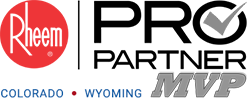
When you seal home air leaks, you conserve your household’s energy usage and improve your indoor air quality. Read on for information on how air seal the leaks in your Colorado or Wyoming home this fall.
Air Leak Trouble Spots
The most common areas where air leaks occur include around doors and windows, plumbing, wiring and cable entrance points, and dryer venting and the like.
Most of the above trouble spots take fairly straightforward air sealing steps. To seal home air leaks, use caulk, weatherstripping or expanding foam, depending on the area.
- Weatherstripping works best around exterior door and window frames and attic hatches.
- Caulking, either latex or silicone, works great for the gaps around plumbing, wiring and cable entrance points, as well as for sealing any small leaks in exposed ductwork.
- For larger holes, such as around your dryer vents and furnace flue, use expanding foam. Apply expanding foam with care, as it does expand substantially during the drying process.
While most of these techniques to seal home air leaks can be readily done by the handy homeowner, when it comes to air sealing your fireplace, recessed lighting and any interior wall ductwork thought to be leaking, you should consider contacting a skilled and trained HVAC technician.
When it comes to recessed lighting, exposed wires are often involved and air sealing must be done with extreme caution.
For your household’s air ducts, trying to reach the ductwork inside your wall can be extremely difficult and clumsy maneuvering can cause more harm than good. However, because your home can lose up to 30 percent of all of its heated and conditioned air through leaky ductwork, it’s extremely important to contact a technician if you suspect air leaks within this system.
For more information on how to seal home air leaks this fall, or to learn about other great energy-saving techniques and products, contact your local professionals at Rheem Pro Partner. Our highly qualified NATE-certified technicians have been proudly serving residents of the Colorado and Wyoming areas since 1992.
Image via Shutterstock.com


